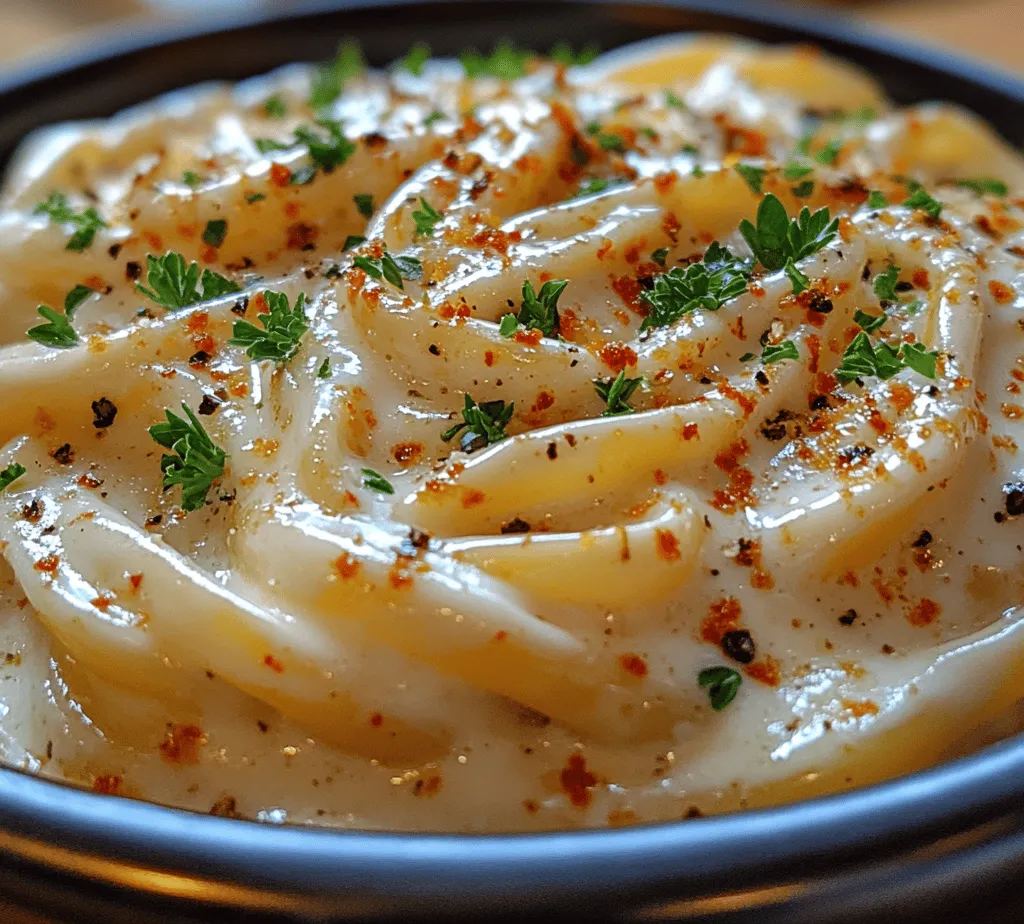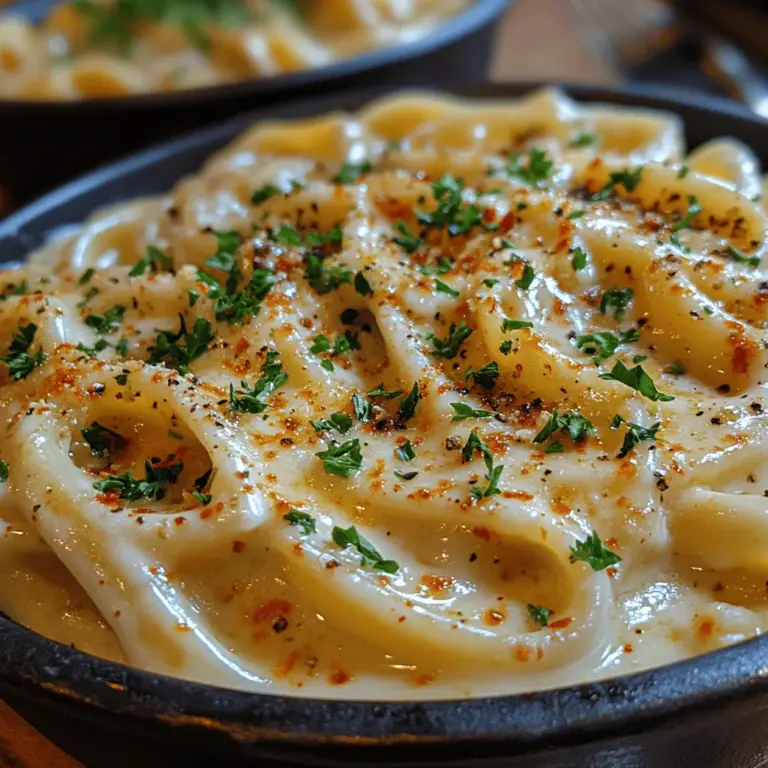Introduction
Fettuccine Alfredo is a beloved classic that has won over the hearts (and taste buds) of pasta lovers worldwide. This creamy dish, characterized by its rich sauce enveloping perfectly cooked fettuccine pasta, is a true representation of Italian cuisine’s ability to transform simple ingredients into a luxurious meal. With its velvety texture and comforting flavors, Fettuccine Alfredo holds a special place not just in Italian kitchens but on tables around the globe.
The popularity of Fettuccine Alfredo can be attributed to its elegant simplicity. While it may be a staple in many Italian restaurants, its origins are deeply rooted in the culinary traditions of Rome. The dish has evolved over time, but its essence remains unchanged—comforting, indulgent, and utterly satisfying. The allure of this pasta dish lies not only in its taste but also in the experience it offers, making it a go-to choice for special occasions, family gatherings, or a cozy night in.
To achieve the ultimate flavor experience with Fettuccine Alfredo, using high-quality ingredients is paramount. Each component plays a crucial role in creating the dish’s signature richness, from the pasta to the cheese and beyond. As you embark on making this creamy delight, you’ll discover how the right choices can elevate your meal from ordinary to extraordinary.
The Allure of Fettuccine Alfredo
Fettuccine Alfredo has a history that dates back to the early 20th century. The dish was created by Alfredo di Lelio, an Italian restaurateur who sought to craft a meal that would please his pregnant wife. He combined fettuccine with a simple mixture of butter and Parmesan cheese, resulting in a dish that was not only delicious but also nourishing. As word spread about this delightful creation, it quickly garnered popularity, particularly among American tourists who fell in love with its rich flavors.
Over the years, variations of Fettuccine Alfredo have emerged, each adding a unique twist to the traditional recipe. In the United States, it’s common to find adaptations that incorporate additional ingredients such as chicken, shrimp, or vegetables, catering to diverse palates and dietary preferences. While these variations offer delightful alternatives, the classic version remains a favorite for its pure simplicity and indulgent taste.
Creamy pasta dishes like Fettuccine Alfredo are inherently comforting. They evoke feelings of warmth and satisfaction, making them a perfect choice for cozy dinners or festive gatherings. The combination of rich cream, savory cheese, and fresh pasta creates a symphony of flavors and textures that can turn any meal into a celebration. Whether served as a main course or a side dish, Fettuccine Alfredo is sure to please even the most discerning diners, making it a timeless staple in the world of culinary delights.
Essential Ingredients for the Perfect Alfredo
To create an unforgettable Fettuccine Alfredo, it is essential to gather the right ingredients. Each component contributes to the overall flavor and texture of the dish, ensuring a rich and creamy experience. Here’s a detailed look at the main ingredients you’ll need:
Fettuccine Pasta
Fettuccine is the pasta of choice for this dish due to its ideal texture and thickness. The flat, wide noodles are perfect for holding onto the creamy sauce, allowing each bite to be luxuriously coated. When selecting fettuccine, opt for high-quality, fresh pasta if possible, as it will cook more evenly and provide a superior mouthfeel compared to dried varieties.
Heavy Cream
Heavy cream is the cornerstone of a rich Alfredo sauce. Its high-fat content ensures a luxurious creaminess that makes the sauce velvety smooth. When heated, heavy cream thickens beautifully, creating a rich base that envelopes the fettuccine. For the best flavor, choose a heavy cream that is free from additives or stabilizers.
Unsalted Butter
Butter is essential in Fettuccine Alfredo, adding depth and richness to the sauce. Unsalted butter is preferred, as it allows you to control the saltiness of the final dish. When melted and combined with the cream, butter enhances the overall flavor profile and contributes to the silky texture of the sauce.
Parmesan Cheese
Parmesan cheese is a crucial ingredient in Fettuccine Alfredo, providing a sharp, nutty flavor that balances the richness of the cream and butter. For the best results, use freshly grated Parmesan cheese rather than pre-packaged options, which often contain anti-caking agents that can affect the sauce’s texture. Authentic Parmigiano-Reggiano is an excellent choice, known for its complex flavor and quality.
Mozzarella Cheese
While not traditional in all variations, adding mozzarella cheese can enhance the creaminess of the dish. Its mild flavor and stretchy texture contribute to the overall indulgence of the sauce. When using mozzarella, make sure it’s high-quality and preferably fresh to achieve that perfect melt.
Garlic
Garlic is a flavor enhancer that adds aromatic notes to the Alfredo sauce. Whether minced or sautéed, garlic provides a subtle fragrance that elevates the dish. Be cautious not to overpower the sauce with too much garlic; a little goes a long way in complementing the cream and cheese.
Nutmeg
Adding a pinch of nutmeg is a traditional technique in many creamy pasta dishes. This warm spice enhances the overall flavor profile of Fettuccine Alfredo, providing a hint of depth that balances the richness of the sauce. Use freshly grated nutmeg for the best flavor impact.
Seasonings
Simple seasonings such as salt and black pepper are essential for bringing out the flavors in your Fettuccine Alfredo. A touch of red pepper flakes can be added for those who enjoy a little heat, but this is entirely optional. Seasoning to taste is key, as it allows you to customize the dish to your preferences.
Fresh Parsley
Finally, fresh parsley serves as a vibrant garnish that adds both color and a hint of freshness to the finished dish. Chopped parsley sprinkled on top just before serving not only enhances the visual appeal but also contributes a subtle herbal note that balances the richness of the Alfredo sauce.
Step-by-Step Instructions to Craft Your Fettuccine Alfredo
Creating the perfect Fettuccine Alfredo is a straightforward process that yields impressive results. Follow these step-by-step instructions to craft this indulgent dish.
1. Cook the Fettuccine: Begin by bringing a large pot of salted water to a rolling boil. Add the fettuccine and cook according to the package instructions until al dente. Remember to reserve about a cup of the pasta cooking water before draining the pasta. This starchy water will help adjust the sauce’s consistency later on.
2. Prepare the Sauce: In a large skillet over medium heat, melt the unsalted butter. Once melted, add minced garlic and sauté for about a minute until fragrant, being careful not to brown it. Pour in the heavy cream and bring to a gentle simmer.
3. Incorporate the Cheeses: Lower the heat and gradually whisk in the grated Parmesan cheese, allowing it to melt into the cream. Stir in the mozzarella cheese, followed by a pinch of nutmeg, salt, and pepper to taste. Continue to cook on low heat until the sauce is smooth and creamy.
4. Combine Pasta and Sauce: Add the cooked fettuccine directly into the skillet with the Alfredo sauce. Toss the pasta gently to coat it evenly with the sauce, adding a splash of the reserved pasta water if needed to achieve the desired consistency.
5. Serve and Garnish: Once the pasta is well coated, remove it from the heat. Plate the Fettuccine Alfredo and garnish with chopped fresh parsley for a pop of color and flavor. Serve immediately for the best experience.
The indulgent richness of Fettuccine Alfredo, coupled with its creamy texture and comforting flavors, makes it an unforgettable dish that is sure to impress. From the careful selection of ingredients to the simple yet effective cooking process, each step contributes to the overall experience of this beloved Italian classic. Embrace the flavors and enjoy a bowl of homemade Fettuccine Alfredo that brings the essence of Italy to your dining table.

Cooking the Fettuccine: Best Practices for Achieving Al Dente
Cooking the fettuccine to perfection is crucial for a delightful dining experience. To achieve that ideal al dente texture, start by bringing a large pot of salted water to a rolling boil. The general rule of thumb is to use about 1 tablespoon of salt for every 4 quarts of water. This not only seasons the pasta but also enhances its flavor.
Once the water is boiling, add the fettuccine and stir gently to prevent it from sticking together. Refer to the package instructions for cooking times, but typically, fettuccine takes about 8-12 minutes to cook. To check for doneness, taste a strand a minute or two before the suggested cooking time. The pasta should be tender yet firm to the bite, with a slight chewiness. Once cooked, reserve a cup of pasta water for later use, then drain the fettuccine and set it aside.
Preparing the Sauce: Techniques for Perfecting the Butter and Garlic Base
The foundation of a rich and creamy Fettuccine Alfredo lies in the sauce, which begins with a simple yet flavorful butter and garlic base. Start by melting unsalted butter in a large skillet over medium heat. The key to developing a deep flavor is to allow the butter to brown slightly without burning, which brings out its nutty flavor.
Once the butter is melted, add minced garlic and sauté for about 1 minute until fragrant. Be cautious not to let the garlic brown, as it can turn bitter. Stir consistently to ensure even cooking. This step is essential; the aromatic garlic will infuse the sauce with a wonderful depth of flavor.
Adding the Cream: Tips for Creating a Smooth Sauce
With the garlic perfectly sautéed, it’s time to add heavy cream. Pour in the cream gradually while stirring continuously. This technique prevents the sauce from separating and helps create a smooth, velvety texture.
Allow the cream to simmer gently; avoid boiling, as high temperatures can cause the cream to curdle. Simmering for about 5-7 minutes allows the sauce to thicken slightly, creating a luxurious coating for the pasta. If you find the sauce too thick, don’t hesitate to add a splash of the reserved pasta water to reach your desired consistency.
Incorporating the Cheese: How to Ensure a Lump-Free Creamy Texture
The next step is to incorporate the cheese, which is essential for achieving that signature creamy consistency. Grate fresh Parmesan cheese and add it to the sauce gradually while stirring. Using fresh cheese instead of pre-grated versions is crucial, as it melts better and contributes to a smoother texture.
To prevent lumps, ensure that the cheese is at room temperature before adding it to the sauce. Stir continuously until the cheese is fully melted and incorporated into the creamy mixture. A traditional Fettuccine Alfredo uses Parmesan, but feel free to experiment with Pecorino Romano for a sharper flavor or a combination of cheeses for added complexity.
Seasoning Your Sauce: Balancing Flavors for the Perfect Taste
Once the cheese is fully melted, it’s time to season your sauce. Begin with a pinch of salt and freshly cracked black pepper, tasting as you go to achieve your preferred flavor profile. You can also add a touch of nutmeg, which complements the creaminess and adds depth to the dish.
If you prefer a bit of acidity to balance the richness, a splash of lemon juice or a sprinkle of lemon zest can brighten the flavors beautifully. This step enhances the overall taste of the dish and ensures a well-rounded flavor profile.
Combining Pasta and Sauce: Techniques for Achieving the Ideal Consistency
Now that your sauce is ready, it’s time to bring everything together. Add the cooked fettuccine to the skillet with the sauce, tossing gently to coat the pasta evenly. If the sauce appears too thick, gradually add reserved pasta water until the desired consistency is achieved. This step is crucial; the starchy pasta water not only helps to thin the sauce but also allows it to adhere better to the noodles.
Continue to toss the pasta in the sauce over low heat for a minute or two. This not only warms the dish through but also allows the pasta to absorb some of the creamy sauce, enhancing the overall flavor. The result should be a luscious, creamy coating on each strand of fettuccine.
Serving Suggestions and Pairings
Fettuccine Alfredo is a versatile dish that can be dressed up or served simply, making it perfect for various occasions. Here are some creative serving ideas and suggestions to complement your meal:
Creative Serving Ideas for Fettuccine Alfredo
1. Garnish with Fresh Herbs: Top your fettuccine with freshly chopped parsley or basil for a pop of color and freshness. A sprinkle of freshly cracked black pepper can also enhance the presentation.
2. Add Proteins: For a heartier meal, consider adding grilled chicken, shrimp, or sautéed mushrooms. These ingredients can elevate the dish and provide additional flavors and textures.
3. Experiment with Vegetables: Incorporate seasonal vegetables like spinach, asparagus, or sun-dried tomatoes for added nutrition and flavor. Sauté them briefly before adding the fettuccine to the sauce.
Suggested Side Dishes to Complement the Meal
1. Light Green Salads: A refreshing side salad with mixed greens, cherry tomatoes, and a light vinaigrette can balance the richness of the Alfredo. The crispness and acidity of the salad help cleanse the palate.
2. Crusty Bread: Serve with a warm, crusty bread or garlic bread to soak up the delicious creamy sauce. This pairing is not only practical but also enhances the overall dining experience.
3. Wine Pairings: To elevate your meal, consider serving Fettuccine Alfredo with a glass of white wine. A Chardonnay or Pinot Grigio pairs beautifully, complementing the richness of the dish without overwhelming it.
Nutritional Insights
Fettuccine Alfredo is undoubtedly indulgent, but understanding its nutritional content can help you enjoy it in moderation. A typical serving contains approximately 600-800 calories, depending on the ingredients used. It is rich in carbohydrates, fats, and proteins, primarily from the pasta and cream. While it is a delicious treat, it’s essential to balance such meals within your overall dietary intake.
Discussion on Balance of Indulgence and Moderation
Enjoying meals like Fettuccine Alfredo can be part of a balanced diet when consumed mindfully. Consider serving smaller portions alongside a generous salad or vegetable side dish. This approach allows you to savor the flavors of the Alfredo while maintaining a varied and healthy diet.
Alternatives for Healthier Variations Without Sacrificing Flavor
For those looking for lighter alternatives, consider these modifications:
– Use Whole Wheat Pasta: Switch to whole wheat fettuccine for added fiber and nutrients.
– Make a Lighter Sauce: Substitute some of the heavy cream with low-fat milk or Greek yogurt for a creamy texture with fewer calories.
– Incorporate Cauliflower: Blend steamed cauliflower into the sauce for added creaminess while reducing calories.
These variations can help you enjoy the flavors of Fettuccine Alfredo while aligning more closely with health goals.
Conclusion
Making homemade Fettuccine Alfredo is a rewarding culinary experience that brings joy to both the cook and the diners. The process of creating a rich and creamy sauce, combined with perfectly cooked pasta, results in a dish that is not only comforting but also a crowd-pleaser for gatherings and special occasions.
As you experiment with the recipe, don’t hesitate to personalize it with your favorite ingredients or variations. Whether you keep it classic or explore new flavors, Fettuccine Alfredo remains a beloved staple that celebrates the joy of cooking and sharing delicious meals. Embrace the indulgence, relish the flavors, and make it a part of your culinary repertoire.

